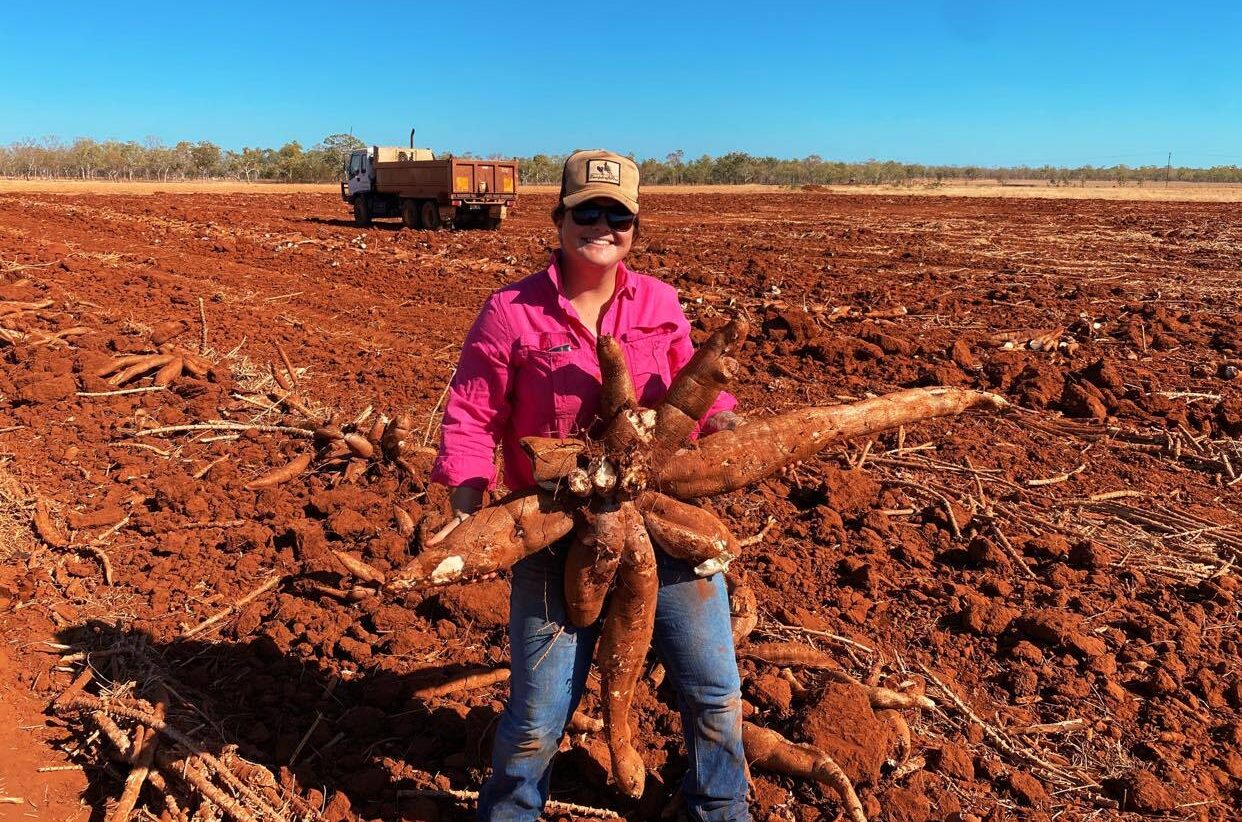Cassava Project
The Northern Territory Department of Industry, Tourism and Trade (NT DITT) is collaborating with the University of Queensland (UQ) on a project which has been funded by the Australian Centre for International Agricultural Research (ACIAR) to generate practical rations for diets and to test these in villages and medium-scale feedlot enterprises in Indonesia. In this project, the NT DITT was responsible for conducting an experiment to measure the liveweight gain response of Brahman steers to increasing levels of cassava tuber with two different protein sources (cavalcade hay and soya bean meal). This study was conducted at the Katherine Research Station where staff were responsible for growing, harvesting and treating cassava products so they could be fed to livestock.

Objectives
By December 2020, the project will have:
- Measured the liveweight gain response of Brahman steers to increasing levels of cassava bulbs with two different protein sources.
Trial design
Twenty Bos indicus weaner steers (178 kg average live weight [LW]) were allocated to one of 4 nutritional diets (5 steers/diet) to evaluate develop growth response growth curves for Brahman steers fed diets containing increasing amounts of cassava tuber with two alternative protein sources. The base cassava mixture included: 97% cassava tuber, 2% urea and 1% trace mineral mix (on a dry matter basis). The total rations for each treatment (T) were as follows:
- T1: base ration + 0.5% LW hay
- T2: 80% base ration + 20% soybean meal + 0.5% LW hay
- T3: 77% base ration + 19% soybean meal + 4% molasses + 0.5% LW hay
- T4: 77% base ration + 19% soybean meal + 4% molasses + 1.0% LW hay
The experiment was conducted at the Katherine Research Station, NT, and steers remained in the same individual pen throughout the experiment with water available at all times. Treatment diets were fed at 0.5% of LW initially and incrementally increased by 0.5% LW every three days until day 15 after which cassava rations were fed ad libitum until the end of the experiment (29 days). Treatment rations and hay intakes were measured daily. Liveweight gain (LWG) was calculated by the difference in LW between start and end of the experiment, which were recorded following a 12 h feed and water curfew. Rumen pH was measured prior to feeding on the final day of the experiment.
Results
The daily concentrate, hay and total intake was monitored over the experiment with total dietary intake tending to decrease with diets containing increasing cassava tuber content. Cassava tuber represented 67% (T1), 56% (T2), 52%, (T3), and 48% (T4) of the diet for each of the treatments, and total dietary intakes (% LW) were 1.6, 1.7, 1.7 and 2.2 respectively. The significantly higher total dietary intake observed for T4 (P<0.001), when compared to each of the other treatments, was partly explained by the increased amount of hay included for that treatment. Hay intake averaged 0.80% LW/d for T4 and between 0.49% and 0.50% LW/d for the remaining treatments.
Total dietary intake was a strong predictor of LWG (P<0.0001), explaining 74% of the variance for LWG. The LWG of steers fed T4 was 1.41 kg/d, significantly higher that T1 (0.16 kg/d; P<0.0001), T2 (0.57 kg/d; P<0.01) and T3 (0.37 kg/d; P<0.001) treatments. Differences in concentrate intake tended towards significance (P=0.08), with T1 consuming the least amount (1.1% LW/d), followed by T2 (1.3% LW/d) and T3 (1.2% LW/d). Interestingly, the concentrate intake of T4 was 0.2% higher than T3, with the only difference between the two treatment diets being increased access to hay. This difference in intake was not significant, however (P=0.13). There was no evidence of treatment effects on rumen pH.
Conclusion
This experiment was successful in adapting yearling steers to diets differing in cassava tuber content and ration formulation, and further demonstrated that cattle fed high-energy diets based on dried cassava tuber can perform well. The results from this experiment are also consistent with the anecdotal reports that intake and LWG is suppressed when inclusion rates of cassava exceed 50% of the total diet. The cause of this association is not well understood and requires further investigation.
Additional information
NT Country Hour Interview March 2020 (starting at 19:25)
NT Country Hour Interview January 2019 (starting at 15:54)
For more information about the project, contact Tim Schatz, Principal Livestock Scientist, Northern Territory Department of Industry, Tourism and Trade on (08) 8973 9771.